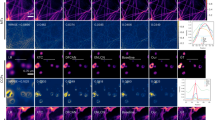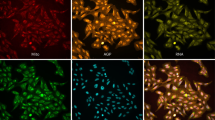Abstract
Light-sheet imaging of cleared and expanded samples creates terabyte-sized datasets that consist of many unaligned three-dimensional image tiles, which must be reconstructed before analysis. We developed the BigStitcher software to address this challenge. BigStitcher enables interactive visualization, fast and precise alignment, spatially resolved quality estimation, real-time fusion and deconvolution of dual-illumination, multitile, multiview datasets. The software also compensates for optical effects, thereby improving accuracy and enabling subsequent biological analysis.
This is a preview of subscription content, access via your institution
Access options
Access Nature and 54 other Nature Portfolio journals
Get Nature+, our best-value online-access subscription
$29.99 / 30 days
cancel any time
Subscribe to this journal
Receive 12 print issues and online access
$259.00 per year
only $21.58 per issue
Buy this article
- Purchase on Springer Link
- Instant access to full article PDF
Prices may be subject to local taxes which are calculated during checkout



Similar content being viewed by others
Data availability
Small example datasets are available for download from the Open Science Foundation at https://osf.io/bufza/. Larger datasets are available on request. Additional datasets uploaded at a later stage will be linked from the documentation page which can be found at https://imagej.net/BigStitcher#Example_Datasets. Example datasets are explained in detail in Supplementary Note 18.
Code availability
All source code used in this publication (BigStitcher, phase correlation simulation and benchmarks, and the simulation of light propagation in tissue using ray tracing) is open-source and published under the GNU General Public License version 2. The latest stable releases used in this publication are provided as Supplementary Software; current versions that include bugfixes and updates can be downloaded from GitHub (at https://github.com/PreibischLab/BigStitcher; https://github.com/PreibischLab/multiview-reconstruction; and https://github.com/PreibischLab/multiview-simulation; see Supplementary Notes 19 and 20 for further explanations). Details on how to use the software are described in Supplementary Note 21.
References
Chung, K. et al. Nature 497, 332–337 (2013).
Chen, F., Tillberg, P. W. & Boyden, E. S. Science 347, 543–548 (2015).
Huisken, J., Swoger, J., Del Bene, F., Wittbrodt, J. & Stelzer, E. H. K. Science 305, 1007–1009 (2004).
Chhetri, R. K. et al. Nat. Methods 12, 1171–1178 (2015).
Huisken, J. & Stainier, D. Y. R. Opt. Lett. 32, 2608–2610 (2007).
Tomer, R., Ye, L., Hsueh, B. & Deisseroth, K. Nat. Protoc. 9, 1682–1697 (2014).
Richardson, D. S. & Lichtman, J. W. Cell 162, 246–257 (2015).
Pietzsch, T., Saalfeld, S., Preibisch, S. & Tomancak, P. Nat. Methods 12, 481–483 (2015).
Linkert, M. et al. J. Cell Biol. 189, 777–782 (2010).
Pietzsch, T., Preibisch, S., Tomancák, P. & Saalfeld, S. Bioinformatics 28, 3009–3011 (2012).
Kuglin, C. D. & Hines, D. C. in Proc. IEEE International Conference on Cybernetics and Society 163–165 (IEEE, 1975)
Preibisch, S., Saalfeld, S. & Tomancák, P. Bioinformatics 25, 1463–1465 (2009).
Emmenlauer, M. et al. J. Microsc. 233, 42–60 (2009).
Chalfoun, J. et al. Sci. Rep. 7, 4988 (2017).
Saalfeld, S., Fetter, R., Cardona, A. & Tomancák, P. Nat. Methods 9, 717–720 (2012).
Bria, A. & Ianello, G. BMC Bioinformatics 13, 316 (2012).
Besl, P. J. & McKay, N. D. IEEE Trans. Pattern Anal. Mach. Intell. 14, 239–256 (1992).
Migliori, B. et al. BMC Biol. 16, 57 (2018).
Schaefer, S., McPhail, T. & Warren, J. ACM Trans. Graph. 25, 533–540 (2006).
Ryan, D. P. et al. Nat. Commun. 8, 612 (2017).
Royer, L. A. et al. Adaptive light-sheet microscopy for long-term, high-resolution imaging in living organisms. Nat. Biotechnol. 34, 1267–1278 (2016).
Nieuwenhuizen, R. P. J. et al. Nat. Methods 10, 557–562 (2013).
Preibisch, S. et al. Nat. Methods 11, 645–648 (2014).
Gao, R. et al. Science 363, eaau8302 (2019).
Schindelin, J. et al. Nat. Methods 9, 676–682 (2012).
Sakkou, M. et al. Cell Metab. 5, 450–463 (2007).
Nguyen, J. P., Linder, A. N., Plummer, G. S., Shaevitz, J. W. & Leifer, A. M. PLoS Comput. Biol. 13, e1005517 (2017).
Karp, X. in WormBook (ed. The C. elegans Research Community, 2016); https://doi.org/10.1895/wormbook.1.180.1
Pfeiffer, D. B. et al. Proc. Natl Acad. Sci. USA 105, 9715–9720 (2008).
Tillberg, P. W. et al. Nat. Biotechnol. 34, 987–992 (2016).
Preibisch, S., Saalfeld, S., Schindelin, J. & Tomancák, P. Nat. Methods 7, 418–419 (2010).
Smith, C. S. et al. J. Cell Biol. 209, 609–619 (2015).
Lowe, D. G. Int. J. Comput. Vis. 60, 91–110 (2004).
Matsuda, A., Schermelleh, L., Hirano, Y., Haraguchi, T. & Hiraoka, Y. Sci. Rep. 8, 7583 (2018).
Weigert, M., Subramanian, K., Bundschuh, S. T., Myers, E. W. & Kreysing, M. PLoS Comput. Biol. 14, e1006079 (2018).
Fischler, M. A. & Bolles, R. C. Commun. ACM 24, 381–395 (1981).
Cleveland, W. S. J. Am. Stat. Assoc. 74, 829–836 (1979).
Preibisch, S., Rohlfing, T., Hasak, M. P. & Tomancák, P. in Proc. of the International Society for Optics and Photonics, Medical Imaging (eds. Reinhardt, J. M. & Pluim, J. P. W.) (SPIE, 2008).
Blasse, C. et al. Bioinformatics 33, 2563–2569 (2017).
Schmied, C., Steinbach, P., Pietzsch, T., Preibisch, S. & Tomancák, P. Bioinformatics 32, 1112–1114 (2016).
Acknowledgements
We thank T. Pietzsch and S. Saalfeld for insightful discussions and BigDataViewer and ImgLib2 support; N. Vladimirov for very helpful microscopy discussions; C. Rueden for Fiji support and maintenance; N. Gompel for early-stage project discussions; and the Caenorhabditis Genetics Center at the University of Minnesota for providing C. elegans strains. S.P., F.P. and M.T. were funded by MDC Berlin; S.P. was supported by HFSP grant RGP0021/2018-102; F.P. was funded by a PhD fellowship from Studienstiftung des deutschen Volkes; F.R.R. and M.T. were funded by the Helmholtz Alliances ICEMED and AMPro; D.H., H.H. and H.L. were funded by the Deutsche Forschungsgemeinschaft (DFG, Nanosystems Initiative Munich), the NHGRI/NIH Center for Photogenomics (grant RM1 HG007743) and LMU Munich; and P.T., N.R., R.K.C., A.C. and P.J.K. were funded by HHMI Janelia.
Author information
Authors and Affiliations
Contributions
S.P. conceived the idea in discussions with H.H., H.L. and M.T.; D.H. and S.P. developed the algorithms and implemented the software; F.R.R. performed all clearing experiments, reconstructions and benchmarks; F.P. imaged and reconstructed C. elegans; P.T. and N.R. performed ExM sample preparation; R.K.C. and P.J.K. developed the ExM-optimized IsoView microscope and imaged the sample; S.P. reconstructed the ExM sample; S.P., M.T., H.L., H.H., P.J.K. and A.C. supported and supervised the project; and S.P., D.H. and F.R.R. wrote the manuscript with input from the co-authors.
Corresponding author
Ethics declarations
Competing interests
The authors declare no competing interests.
Additional information
Peer review information: Rita Strack was the primary editor on this article and managed its editorial process and peer review in collaboration with the rest of the editorial team.
Publisher’s note: Springer Nature remains neutral with regard to jurisdictional claims in published maps and institutional affiliations.
Supplementary information
Supplementary Information
Supplementary Figs. 1–23, Supplementary Tables 1 and 2 and Supplementary Notes 1–21.
Supplementary Video 1
Interactive link verification.
Supplementary Video 2
Simulations of light propagation in tissue.
Supplementary Video 3
Interactive walk through a cleared sample.
Supplementary Video 4
Quality of multiview registration on the expanded sample.
Supplementary Video 5
3D maximum-intensity projection of the expanded sample.
Supplementary Video 6
Low-resolution overview of reconstructed mouse brain.
Supplementary Video 7
3D maximum-intensity projection of the reconstructed C. elegans dauer.
Supplementary Video 8
Quality measurement by rFRC (single image tile).
Supplementary Video 9
Quality measurement by rFRC (large sample).
Supplementary Software
Source code for BigStitcher, phase correlation simulation and benchmark, and the simulation of light propagation in tissue using ray tracing, all licensed under the GNU General Public License version 2.
Rights and permissions
About this article
Cite this article
Hörl, D., Rojas Rusak, F., Preusser, F. et al. BigStitcher: reconstructing high-resolution image datasets of cleared and expanded samples. Nat Methods 16, 870–874 (2019). https://doi.org/10.1038/s41592-019-0501-0
Received:
Accepted:
Published:
Issue Date:
DOI: https://doi.org/10.1038/s41592-019-0501-0
This article is cited by
-
Signal improved ultra-fast light-sheet microscope for large tissue imaging
Communications Engineering (2024)
-
An end-to-end workflow for nondestructive 3D pathology
Nature Protocols (2024)
-
Benchtop mesoSPIM: a next-generation open-source light-sheet microscope for cleared samples
Nature Communications (2024)
-
Efficient 3D light-sheet imaging of very large-scale optically cleared human brain and prostate tissue samples
Communications Biology (2023)
-
Whole-mouse clearing and imaging at the cellular level with vDISCO
Nature Protocols (2023)



